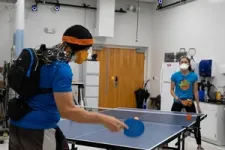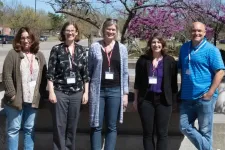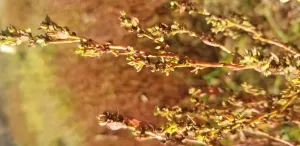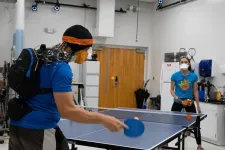(Press-News.org) For the last six years, Indiana University researchers and collaborators from around the world have sought to answer important questions about the most basic laws of physics that govern our universe. Their experiment, the Majorana Demonstrator, has helped to push the horizons on research concerning one of the fundamental building blocks of the universe: neutrinos.
The experiment’s final report was published in Physical Review Letters in February.
Neutrinos – subatomic particles similar to an electron but that have no electric charge – are the second most abundant particles in the universe after light. However, they are some of the hardest particles to measure because they do not interact the way other particles do.
“Neutrinos have a profound impact on the universe and physics at every imaginable scale, surprising us down at the particle interaction level and having broad impact up through the cosmic scales,” said Walter Pettus, an assistant professor of physics in the IU College of Arts and Sciences. “But they are also the most frustrating to study because we know so much about them, yet we have so many gaps.”
The Majorana Demonstrator, a collaboration of 60 researchers from 24 institutions, was designed to fill many of those gaps at the same time, probing into the most fundamental properties of neutrinos.
One aspect they hoped to observe was whether the neutrino could be its own antiparticle – a subatomic particle of the same mass but with the opposite electric charge. Since the neutrino is uncharged, it is the only particle in the universe that could be its own antiparticle. Understanding that would provide insight into why the neutrino has mass in the first place – information which would have wide-spread impacts in understanding how the universe was formed.
To determine if the neutrino is its own antiparticle, the researchers needed to observe a rare occurrence called neutrinoless double-beta decay. However, this process takes a single atom at least 1026 years – significantly longer than the age of the universe. Instead, they chose to observe nearly 1026 atoms over the course of six years.
To observe this incredibly rare decay, the researchers needed the perfect environment. In the Sanford Underground Research Facility in the Black Hills of South Dakota, located a mile underground, they built one of the cleanest and quietest environments on Earth. Extremely sensitive detectors were made of a high-purity germanium and were packed in a 50-ton lead shield and surrounded by materials of unprecedented cleanliness. Even the copper used was grown underground in their lab with impurity levels so low they couldn’t be measured.
Pettus and a team of IU students were responsible primarily for analyzing data from the experiment. Graduate student Nafis Fuad, undergraduate senior Isaac Baker, sophomore Abby Kickbush and Jennifer James, a student with the Research Experiences for Undergraduates Program, have been involved in the project. Their focus has been on understanding the stability of the experiment, analyzing details of the recorded waveforms and characterizing backgrounds.
“It’s like looking for a tiny needle in a very, very, very big haystack – you have to carefully get rid of all the hays (a.k.a. backgrounds) possible, and you don’t even know if there’s actually a needle in there in the first place or not,” Fuad said. “It’s very exciting to be a part of that search.”
While the researchers ultimately did not observe the decay they hoped for, they did discover that the neutrino’s scale for decay is longer than the limit they placed on it, which they will test further during the next phase of the experiment. In addition, they recorded other scientific results – ranging from dark matter to quantum mechanics – that helps provide a better understanding of the universe.
Through the project, the researchers proved that the techniques they utilized could be used at a much larger scale in a potentially game-changing search that could help explain the existence of matter in the universe.
“We didn’t see the decay we were looking for, but we have raised the bar on where to look for the physics we’re going after,” Pettus said. “True to its name, the Demonstrator advanced critical technologies that we are already leveraging for the next phase of the experiment in Italy. We may not have broken our picture of physics yet, but we’ve certainly pushed the horizons, and I am very excited about what we have accomplished.”
The next phase of the project, called LEGEND-200, has already begun taking data in Italy, with plans to run over the next five years. Researchers aim to observe the decay happening at a magnitude higher sensitivity than the Majorana Demonstrator. Beyond that, thanks to support from the U.S. Department of Energy, the team is already designing the successor experiment, LEGEND-1000.
Pettus is excited about the future of this work and looks forward to involving more students on the project, both in data analysis and hardware development for LEGEND-1000.
“If we discover the neutrino is its own antiparticle, there will still be ground under our feet and stars in the sky, and our understanding of physics doesn’t change the reality of the physical laws that always have and continue to govern our universe,” Pettus said. “But knowing what’s down there at the most fundamental level and how the universe works gives us a richer, more beautiful world to live in – or possibly just weirder – and that pursuit is fundamentally human.”
The Majorana Demonstrator was managed by Oak Ridge National Laboratory for the U.S. Department of Energy Office of Nuclear Physics, with support from the National Science Foundation.
END
Better understanding the physics of our universe part of collaborative research effort
Indiana University researchers and collaborators from around the world are seeking to answer important questions about the most basic laws of physics that govern our universe.
2023-04-10
ELSE PRESS RELEASES FROM THIS DATE:
Scientists create model to predict depression and anxiety using artificial intelligence and social media
2023-04-10
Researchers at the University of São Paulo (USP) in Brazil are using artificial intelligence (AI) and Twitter, one of the world’s largest social media platforms, to try to create anxiety and depression prediction models that could in future provide signs of these disorders before clinical diagnosis.
The study is reported in an article published in the journal Language Resources and Evaluation.
Construction of a database, called SetembroBR, was the first step in the study. The name is a reference to Yellow September, an annual suicide awareness and prevention campaign, and also to the fact that ...
Scientists advocate for integration of biogeography and behavioral ecology to rapidly respond to biodiversity loss
2023-04-10
An interdisciplinary team of researchers at the University of Oklahoma has published a perspective article in the journal Proceedings of the National Academy of Sciences advocating for convergent research that integrates the fields of biogeography and behavioral ecology to more rapidly respond to challenges associated with climate change and biodiversity loss.
While news about climate change fills headlines, the crisis of biodiversity loss has gotten less attention. In their article, the authors contend that “identifying solutions that prevent large-scale extinction requires addressing critical questions about biodiversity dynamics that – ...
ACC Cardio-oncology Course equips clinicians, researchers with tools to improve cardiovascular care for cancer patients
2023-04-10
The American College of Cardiology will host the annual Advancing the Cardiovascular Care of the Oncology Patient course on April 14-16, 2023, in Washington, DC. The course is intended for all members of the interprofessional care team—including cardiologists, oncologists, pharmacists and nurses—and aims to equip the global cardio-oncology community with the tools they need to improve patient care.
Ana Barac, MD, PhD, FACC, and Bonnie Ky, MD, MSCE, FACC, will serve as co-directors for the course, which ...
Penn Medicine study reveals new insights on brain development sequence through adolescence
2023-04-10
PHILADELPHIA—Brain development does not occur uniformly across the brain, but follows a newly identified developmental sequence, according to a new Penn Medicine study. Brain regions that support cognitive, social, and emotional functions appear to remain malleable—or capable of changing, adapting, and remodeling—longer than other brain regions, rendering youth sensitive to socioeconomic environments through adolescence. The findings were published recently in Nature Neuroscience.
Researchers charted how developmental processes unfold across the human brain from the ages of 8 to 23 years old ...
Early crop plants were more easily ‘tamed’
2023-04-10
The story of how ancient wolves came to claim a place near the campfire as humanity’s best friend is a familiar tale (even if scientists are still working out some of the specifics). In order to be domesticated, a wild animal must be tamable — capable of living in close proximity to people without exhibiting dangerous aggression or debilitating fear. Taming was the necessary first step in animal domestication, and it is widely known that some animals are easier to tame than others.
But did humans also favor certain wild plants for domestication because they were more easily “tamed”? Research from Washington University in St. ...
Table tennis brain teaser: Playing against robots makes our brains work harder
2023-04-10
Captain of her high school tennis team and a four-year veteran of varsity tennis in college, Amanda Studnicki had been training for this moment for years.
All she had to do now was think small. Like ping pong small.
For weeks, Studnicki, a graduate student at the University of Florida, served and rallied against dozens of players on a table tennis court. Her opponents sported a science-fiction visage, a cap of electrodes streaming off their heads into a backpack as they played against either Studnicki or a ball-serving machine. That cyborg look was vital ...
For chatbots and beyond: Improving lives with data starts with improving machine learning
2023-04-10
You’d be hard pressed to find an industry today that doesn’t use data in some capacity. Whether it's health care workers using data to report the rate of flu infections in a certain state, manufacturers using data to better understand average production times, or even a small coffee shop owner flipping through sales data to learn about the previous month’s bestselling latte, data can reveal patterns and offer insights into our everyday behavior.
All of this data plays a critical role in artificial intelligence ...
Mild COVID during pregnancy does not slow brain development in babies, study finds
2023-04-10
NEW YORK, NY (April 10, 2023)--Columbia researchers have found that babies born to moms who had mild or asymptomatic COVID during pregnancy are normal, based on results from a comprehensive assessment of brain development.
The findings expand on a smaller study that used maternal reports to assess the development of babies born in New York City during the first wave of the pandemic. That study found no differences in brain development between babies who were exposed to COVID in utero and those who were not exposed.
For the new study, the researchers developed a method of observing infants remotely, ...
Kids judge Alexa smarter than Roomba, but say both deserve kindness
2023-04-10
DURHAM, N.C. –- Most kids know it’s wrong to yell or hit someone, even if they don’t always keep their hands to themselves. But what about if that someone’s name is Alexa?
A new study from Duke developmental psychologists asked kids just that, as well as how smart and sensitive they thought the smart speaker Alexa was compared to its floor-dwelling cousin Roomba, an autonomous vacuum.
Four- to eleven-year-olds judged Alexa to have more human-like thoughts and emotions than Roomba. But despite the perceived difference in intelligence, kids felt neither the Roomba nor the Alexa deserve to be yelled at or harmed. That feeling dwindled as kids advanced ...
Hooper creating public database of slaving voyages across the Indian Ocean and Asia
2023-04-10
Jane Hooper, Associate Professor, History, received funding for the project: "Global Passages: Creating a Public Database of Slaving Voyages across the Indian Ocean and Asia."
Hooper, along with three other scholars, has received a three-year digital production grant from the National Endowment for the Humanities to support a major expansion of the open access SlaveVoyages website, available online at https://www.slavevoyages.org. The primary investigators will create an Indian Ocean and Asia (IOA) database of voyages that ...
LAST 30 PRESS RELEASES:
Tracing the quick synthesis of an industrially important catalyst
New software sheds light on cancer’s hidden genetic networks
UT Health San Antonio awarded $3 million in CPRIT grants to bolster cancer research and prevention efforts in South Texas
Third symposium spotlights global challenge of new contaminants in China’s fight against pollution
From straw to soil harmony: International team reveals how biochar supercharges carbon-smart farming
Myeloma: How AI is redrawing the map of cancer care
Manhattan E. Charurat, Ph.D., MHS invested as the Homer and Martha Gudelsky Distinguished Professor in Medicine at the University of Maryland School of Medicine
Insilico Medicine’s Pharma.AI Q4 Winter Launch Recap: Revolutionizing drug discovery with cutting-edge AI innovations, accelerating the path to pharmaceutical superintelligence
Nanoplastics have diet-dependent impacts on digestive system health
Brain neuron death occurs throughout life and increases with age, a natural human protein drug may halt neuron death in Alzheimer’s disease
SPIE and CLP announce the recipients of the 2025 Advanced Photonics Young Innovator Award
Lessons from the Caldor Fire’s Christmas Valley ‘Miracle’
Ant societies rose by trading individual protection for collective power
Research reveals how ancient viral DNA shapes early embryonic development
A molecular gatekeeper that controls protein synthesis
New ‘cloaking device’ concept to shield sensitive tech from magnetic fields
Researchers show impact of mountain building and climate change on alpine biodiversity
Study models the transition from Neanderthals to modern humans in Europe
University of Phoenix College of Doctoral Studies releases white paper on AI-driven skilling to reduce burnout and restore worker autonomy
AIs fail at the game of visual “telephone”
The levers for a sustainable food system
Potential changes in US homelessness by ending federal support for housing first programs
Vulnerability of large language models to prompt injection when providing medical advice
Researchers develop new system for high-energy-density, long-life, multi-electron transfer bromine-based flow batteries
Ending federal support for housing first programs could increase U.S. homelessness by 5% in one year, new JAMA study finds
New research uncovers molecular ‘safety switch’ shielding cancers from immune attack
Bacteria resisting viral infection can still sink carbon to ocean floor
Younger biological age may increase depression risk in older women during COVID-19
Bharat Innovates 2026 National Basecamp Showcases India’s Most Promising Deep-Tech Ventures
Here’s what determines whether your income level rises or falls
[Press-News.org] Better understanding the physics of our universe part of collaborative research effortIndiana University researchers and collaborators from around the world are seeking to answer important questions about the most basic laws of physics that govern our universe.







